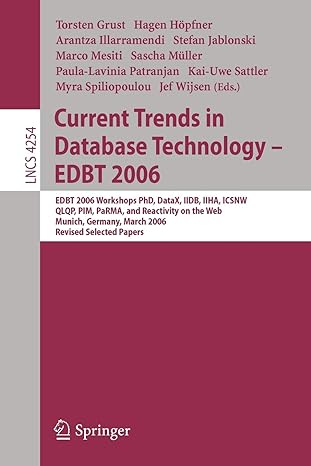Question
I wanted help with writing the bodies of the functions. The constants are: COLUMN_ID = 0 COLUMN_NAME = 1 COLUMN_HIGHWAY = 2 COLUMN_LAT = 3
I wanted help with writing the bodies of the functions.
The constants are:
COLUMN_ID = 0 COLUMN_NAME = 1 COLUMN_HIGHWAY = 2 COLUMN_LAT = 3 COLUMN_LON = 4 COLUMN_YEAR_BUILT = 5 COLUMN_LAST_MAJOR_REHAB = 6 COLUMN_LAST_MINOR_REHAB = 7 COLUMN_NUM_SPANS = 8 COLUMN_SPAN_DETAILS = 9 COLUMN_DECK_LENGTH = 10 COLUMN_LAST_INSPECTED = 11 COLUMN_BCI = 12
INDEX_BCI_YEARS = 0 INDEX_BCI_SCORES = 1 MISSING_BCI = -1.0
EARTH_RADIUS = 6371
This is an example of one of the bridges which is a list.
def create_example_bridge_1() -> list: """Return a bridge in our list-format to use for doctest examples.
This bridge is the same as the bridge from row 3 of the dataset. """
return [ 1, 'Highway 24 Underpass at Highway 403', '403', 43.167233, -80.275567, '1965', '2014', '2009', 4, [12.0, 19.0, 21.0, 12.0], 65.0, '04/13/2012', [['2013', '2012', '2011', '2010', '2009', '2008', '2007', '2006', '2005', '2004', '2003', '2002', '2001', '2000'], [MISSING_BCI, 72.3, MISSING_BCI, 69.5, MISSING_BCI, 70.0, MISSING_BCI, 70.3, MISSING_BCI, 70.5, MISSING_BCI, 70.7, 72.9, MISSING_BCI]] ]
Here is a helper function:
def calculate_distance(lat1: float, lon1: float, lat2: float, lon2: float) -> float: """Return the distance in kilometers between the two locations defined by (lat1, lon1) and (lat2, lon2), rounded to the nearest meter.
>>> calculate_distance(43.659777, -79.397383, 43.657129, -79.399439) 0.338 >>> calculate_distance(43.42, -79.24, 53.32, -113.30) 2713.226 """
# This function uses the haversine function to find the # distance between two locations. You do NOT need to understand why it # works. You will just need to call on the function and work with what it # returns. # Based on code at goo.gl/JrPG4j
# convert decimal degrees to radians lon1, lat1, lon2, lat2 = (math.radians(lon1), math.radians(lat1), math.radians(lon2), math.radians(lat2))
# haversine formula t lon_diff = lon2 - lon1 lat_diff = lat2 - lat1 a = (math.sin(lat_diff / 2) ** 2 + math.cos(lat1) * math.cos(lat2) * math.sin(lon_diff / 2) ** 2) c = 2 * math.asin(math.sqrt(a))
return round(c * EARTH_RADIUS, 3)
With the data above, please help me with the bodies of the functions.
def find_bridge_by_id(bridges: List[list], bridge_id: int) -> list: """Return the data for the bridge with id bridge_id from bridges.
If there is no bridge with the given id in bridges, then return an empty list.
>>> example_bridges = create_example_bridges() >>> find_bridge_by_id(example_bridges, 4) [] >>> find_bridge_by_id(example_bridges, 2) == create_example_bridge_2() True """
def find_bridges_in_radius(bridges: List[list], lat: float, lon: float, radius: int, exclusions: List[int]) -> List[int]: """Return the IDs of the bridges that are within radius kilometres from location (lat, lon). Include bridge IDs that are exactly radius kilometres away. The bridge IDs in exclusions are not included in the result.
Preconditions: - (lat, lon) is a valid location on Earth - radius > 0
>>> example_bridges = create_example_bridges() >>> find_bridges_in_radius(example_bridges, 43.10, -80.15, 50, []) [1, 2] >>> find_bridges_in_radius(example_bridges, 43.10, -80.15, 50, [1, 2]) [] """
def get_bridge_condition(bridges: List[list], bridge_id: int) -> float: """Return the most recent BCI score of the bridge in bridges with id bridge_id.
The most recent BCI score is the BCI score given to the bridge in the highest (i.e., most recent) year. If there is no score for every year, return MISSING_BCI.
>>> example_bridges = create_example_bridges() >>> get_bridge_condition(example_bridges, 1) 72.3 """
Step by Step Solution
There are 3 Steps involved in it
Step: 1

Get Instant Access to Expert-Tailored Solutions
See step-by-step solutions with expert insights and AI powered tools for academic success
Step: 2

Step: 3

Ace Your Homework with AI
Get the answers you need in no time with our AI-driven, step-by-step assistance
Get Started


